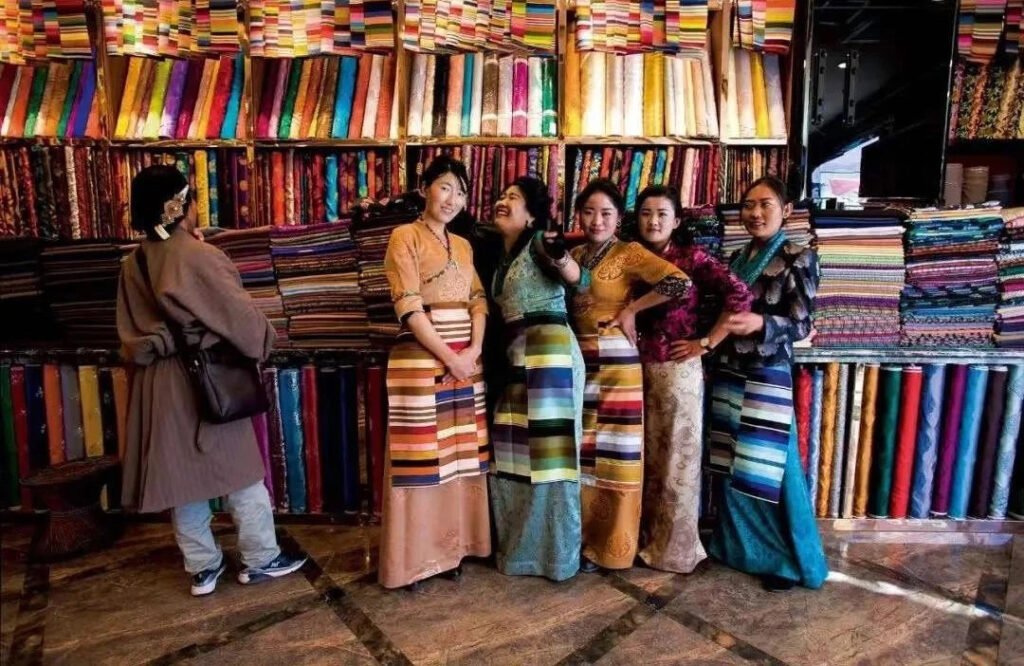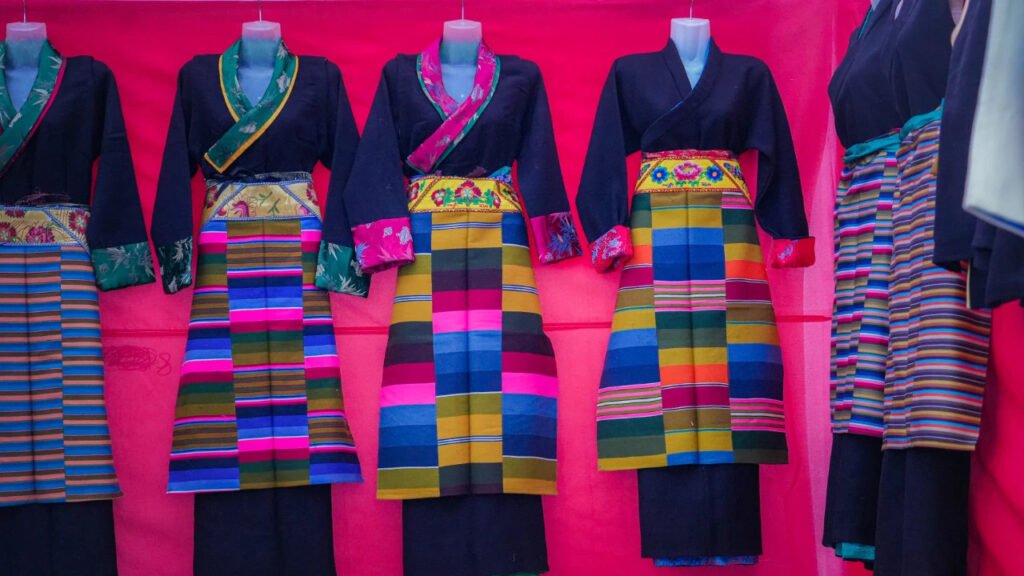The Pangden (པང་གདན་), often referred to as the “Tibetan apron,” is a unique and vibrant symbol of Tibetan culture. Tied around the waist, it’s not just an accessory but a practical and colorful representation of Tibetan heritage, often described as a “rainbow tied around the waist.”
Origins and Functionality of the Pangden
Historically, the Pangden was created to assist Tibetan women in their daily lives. Its initial design aimed to provide convenience for women while holding children close to their bodies, collecting dung for fuel, and offering additional warmth. Over time, it evolved into a decorative and functional piece of clothing.
Made with striped patterns of vibrant, rainbow-like colors, the Pangden dates back over 1,000 years. Historical records suggest that Tibetan ancestors wove its design inspired by rainbows after rainfall. Even today, the tradition of wearing Pangdens thrives in regions like Lhasa and Tsang.
Common Misconceptions
There’s a widespread belief that wearing a Pangden signifies a woman’s marital status. However, this isn’t entirely accurate. In areas like Tsang, Shannan, and Lhasa, young girls aged 15 and above often wear Pangdens as part of their traditional attire, regardless of their marital status.

Exploring the Types, Materials, and Regional Variations of Pangden
The Pangden, a traditional Tibetan apron, is not only a practical garment but also a symbol of cultural pride and artistic expression. Its variety in design, materials, and regional influences highlights the rich heritage of Tibetan craftsmanship.
Types of Pangden
Pangdens are classified into two main types based on their stripe patterns:
- Trachen:
- Characterized by larger striped patterns.
- Creates a bold and striking appearance.
- Trachung:
- Features smaller, more delicate striped patterns.
- Offers a refined and intricate aesthetic.
The choice of pattern often reflects personal preferences and regional traditions, showcasing the versatility of this iconic garment.
Materials Used in Pangden
The material of a Pangden determines its quality, texture, and durability. The two primary materials are:
- Sherma:
- A finer and softer fabric.
- Known for its intricate weaving and luxurious feel.
- Pulu:
- A thicker, woolen material.
- Valued for its durability and warmth, ideal for daily use.
Tibetan women have skillfully combined these materials with natural dyes and patterns, creating Pangdens that are both functional and visually appealing.

Regional Variations of Pangden
Tibetan regions bring unique interpretations to the design and color combinations of Pangdens. In Shannan, particularly in Zhanang and Gonggar, Pangdens are categorized by their distinctive color schemes and patterns:
- Masen Kyungju
- Gacha Besa
- Jazhu Besa
- Nangka Gachun
- Nangka Gachik
Each variation reflects the creativity and cultural identity of Tibetan women, with designs often inspired by nature, local traditions, and aesthetic preferences. These variations add a layer of individuality and pride to each Pangden, connecting it deeply to the wearer’s heritage.
Creativity in Design
Over time, Tibetan women have infused innovation into Pangden designs. By experimenting with diverse color combinations and weaving techniques, they have developed styles that not only meet functional needs but also reflect evolving aesthetic tastes. These creative expressions highlight the artistic prowess and adaptability of Tibetan women, preserving the essence of their traditions while embracing modern influences.
The Pangden is much more than a piece of clothing; it is a cultural emblem that embodies the artistry, resourcefulness, and identity of Tibetan women. From the bold Trachen to the intricate Trachung, and from the fine Sherma to the sturdy Pulu, each Pangden tells a story of tradition and innovation. The regional variations further enrich this heritage, showcasing the deep connection between Tibetan people and their vibrant culture.

Craftsmanship and Cultural Integration
In regions like Tsang, weaving Pangdens is deeply embedded in daily life. For young girls, mastering the craft is a vital skill often tied to marriage prospects. Many households in rural areas and small towns still possess traditional looms.
For example, in Bailang County’s Wangdan Township, nearly every girl learns to weave, with Pangdens showcasing strong regional characteristics. Their designs often emphasize deep red tones, with large, bold stripes of the Chaqin style to create striking contrasts.
The Pangden is more than an apron; it’s a tapestry of Tibetan identity, resilience, and artistry. Its vibrant colors and patterns reflect not just the creativity of Tibetan women but also their enduring connection to cultural traditions.
Pangden: The Symbol of Tibetan Culture and Craftsmanship
The Pangden (པང་གདན་), a distinctive Tibetan apron, continues to play a vital role in the cultural and economic life of Tibet. From the intricate weaving techniques to its symbolic significance, the Pangden remains a testament to the creativity and resilience of Tibetan women.
Regional Traditions and Varieties
In Chamdo’s Mangkam County and Ganzi’s Garong, wearing black Pangdens is a prevalent custom. Meanwhile, Jedexiu Town in Gonggar County, Shannan, is renowned as the “Hometown of Pangden.” This region is a major producer of Pangdens and pulu (a woolen fabric), a legacy dating back centuries. According to tradition, even the clothing of Princess Wencheng was made in Jedexiu.
Today, many artisans in Jedexiu rely on Pangden weaving as their primary livelihood, significantly contributing to the local economy. Unlike the bold designs of the Tsang region, Pangdens from Shannan and Lhasa feature finer, harmonious patterns in subdued tones, often using the Chaqiong stripe style.
Craftsmanship of Pangden
Creating a Pangden requires meticulous craftsmanship:
- Raw Material Selection: High-quality sheep wool is chosen as the base material.
- Preparation: The wool undergoes combing, spinning (fine threads for warp, coarse threads for weft), and dyeing.
- Weaving: Skilled weavers use looms to craft intricate patterns.
- Dyeing: Natural dyes made from Tibetan minerals and plants produce over 20 vibrant, non-fading colors.
- Finishing: The fabric is stiffened, rubbed, and sun-dried for durability.
Traditionally, spinning was exclusively a woman’s task, while weaving was performed by men in certain regions. However, in Shannan, men weaving on looms is more common.

Types of Pangden
Pangdens can be classified into three main types based on materials and quality:
- Sherma: The finest Pangdens, crafted from 14–20 dyed wool threads, requiring intricate spinning and top-quality wool.
- Pulu: Slightly coarser than Sherma, made from thicker wool threads.
- Silk Pangden: Made from imported Indian silk threads, these are lightweight and glossy.
Festive and Daily Pangdens
For festivals, Pangdens are adorned with additional decorations called Trodhen, including golden threads and colorful silk ribbons. These embellishments serve both decorative and practical purposes, such as securing the apron. In contrast, daily Pangdens are simpler, without Trodhen.
Cultural Significance and Taboos
In Tibetan folklore, married women in Tsang must wear a Pangden with traditional attire, as not doing so is believed to attract bad omens. Additionally, it is considered offensive to whip or throw a Pangden at someone, as this act is seen as a curse.
Beyond its practical uses, the Pangden symbolizes Tibetan women’s ingenuity and creativity, often referred to as “the beauty of a rainbow tied at the waist.” The Pangden is more than just a piece of clothing; it is a living heritage, blending tradition, craftsmanship, and culture. From the skilled hands of Tibetan women to its enduring presence in daily life, the Pangden continues to shine as a vibrant symbol of Tibetan identity.

